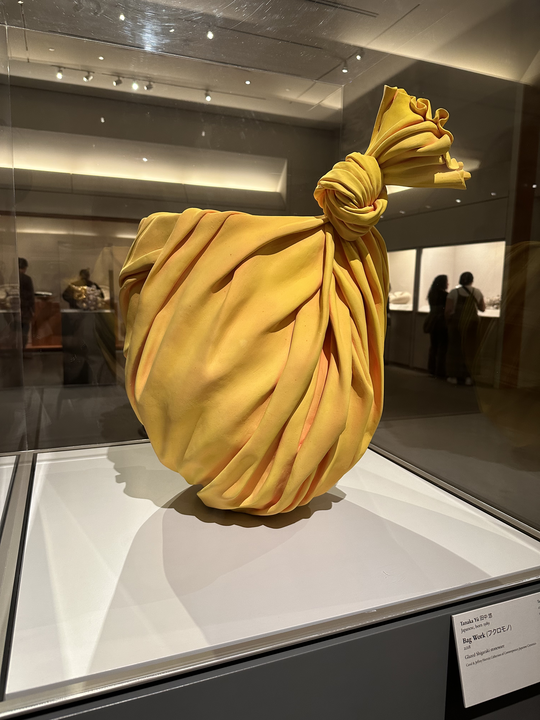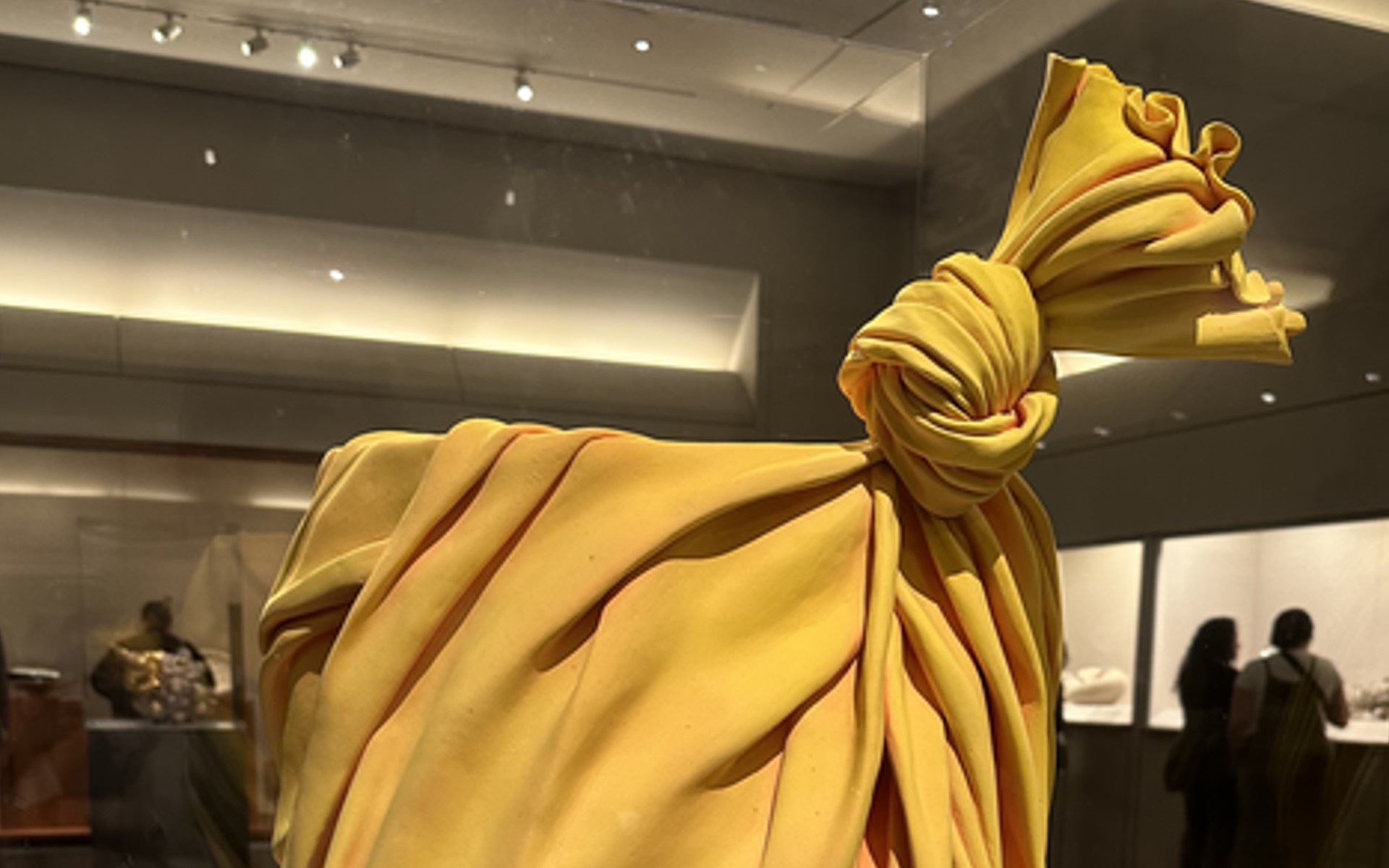CHICAGO — The exhibition lay a long journey away. We passed through a giant hall with a rainbow ceiling, a long low hall with marble sculptures. Later, on a ghost tour, I learned that the union that represents night guards at the Art Institute of Chicago fought to have two people work the night shift, so that no one would have to be alone when the sound of horses' hooves ricocheted down from the marble in the middle of the night. But at the time, I thought about the Louvre: A museum, in my opinion, should be smaller. There was so much to see and in so many different mediums and genres. A brain can only hold so much beautiful art before it begins to disengage.
So we breezed by the marble, and the ancient Greek works, toward an exhibition my sister and mom had seen on a poster near the bathroom. We had no time for this. Only once did I become sidetracked by a very large black vase. It was so large. But no! We were going to see other vases, difficult vases.
Radical Clay: Contemporary Women Artists from Japan was in a side gallery. We breezed past beautiful wood block prints to get there: to a strange open space with low lighting, where pots the size of my torso sat regally in glass boxes, protected from harm. Immediately, I knew which piece I was drawn to. Sometimes something magical happens in a gallery, almost like when Jacob imprints on Renesmee in Twilight, where it feels as if a single piece chooses you.
A golden thread reaches out from that piece, and connects itself to you in the low light. It is the same feeling one gets at a wedding reception, when someone you love is across a vast room, past a dozen people, and even though you do not look at one another, the strength of presence is so great that you know where they are, how they feel. There's a security in that thread, that allows you to talk to other people. You don't need to return to them first. They will be there when you get to them. You can say hi to the others.
So it was between one beautiful clay pot and me. I felt the thread, her radiating warmth, and I went elsewhere, observed the other beautiful things that had been made so delicately, with such careful hands. One of them, Konno Tomoko's Liberation, was adorned with thousands of tiny clay feathers, the size of grains of rice. It was spooky, like an alien. It was so delicate. I spent longer than I wanted to looking at the little veins carefully painted on its petals. It is an act of resistance to look at the other pieces before the one you are drawn to, a force of will.
Finally, I was ready to confront my beloved: Tanaka Yu's Bag Work.
Bag Work is a large vessel. It was sitting on a four foot tall pedestal in the gallery, and came up to my height, so it is at least 16 inches high. It is yellow. So yellow. Yellow like a big block of butter. Yellow like the sun if you look right at it. Yellow like the leaves of the ginkgo tree in the fall. It is clay that is made to look as if it is fabric. From the little card in the gallery, I learned that often valuables in families in Japan are wrapped in cloth to keep them safe. This is what Yu is trying to emulate, that protection. It is impossible to look at Bag Work without imagining what could be inside, what is wrapped so carefully. But of course there is nothing in there. It is only clay.

Not only is it clay: It's a damn coil pot.
Almost everyone has made a coil pot. Coil pots are a big player in elementary school art classes. You take your clay, and you roll it into a snake. Then you place the snake in a shape.Then you score the snake (slash it up) and slather it with slip (runny clay). You make another snake of clay and place it on top of the snake you already have.
What that means practically, for a pot like this, is that Yu needs to know exactly where the bends of those fabric lines will be from the moment she lays that first snake, and to understand how they need to move and change ever so slightly at each level. It is masterful. It is beautiful. It is so delicate.
The thing I love about pottery is that it can break. Tove Ditlevsen, one of my favorite writers, was obsessed with broken vases. Toward the end of her book The Faces, Ditlevsen's narrator hallucinates an interaction with her long-dead mother. Her mother asks if she remembers being left home alone as a child and breaking a beautiful vase. The narrator does. She says she regrets it, and her mother rebukes her for it, saying it was the only thing she had of her own mother's, her only connection to her.
"‘I didn’t want to repeat your lives," the narrator says. "I wanted to have my own."
In her poem "Recognition," Ditlevsen describes the same scene. "Only because it was so wild and daring, in all that tension the forbidden ignites," she writes. Once it shatters, the poem says, "the world became evil and without joys. Ten Thousand Shards can never be healed again."
In Vigdis Hjorth's novel Will and Testament, which I stayed up late last night finishing, the narrator pushes "Recognition" a bit farther. "But what if the world had been wicked and joyless all along, only she had to break the vase in order to know it?"
When I read this last night, I thought of Tanaka. Doesn't Hjorth's theory then mean that every beautiful vase left standing in the world is a radical stance that joy and beauty persist despite our capabilities? No matter how wicked and demonic we are, people are still making beautiful vases, as they have done for thousands of years. The vases serve no purpose but to remind us that we are capable of joy, of excitement, of curiosity. The evolution of ceramic forms, maybe, is to Ditlevsen's first point, the ability to prove that we are not our mothers, that we can build something of the same material in the same manner, and end up somewhere entirely different.
Yu Tanaka, I later learned, is still young in her career. Born in 1989, she is only a little older than me. I feel as if I have only really begun to create things which come close to the ideal inside my mind. I wonder if she feels that way too. I wonder if she too thinks about fragility when she builds, about the precarity of her art as it travels around the world to be shown, about how all clay work is radical in its bravery, and optimistic in its creation. I wonder if she imagines unwrapping her pieces, as I do, even though she knows that there is nothing inside.
Radical Clay: Contemporary Women Artists from Japan is on view at the Art Institute of Chicago until June 3, 2024.






